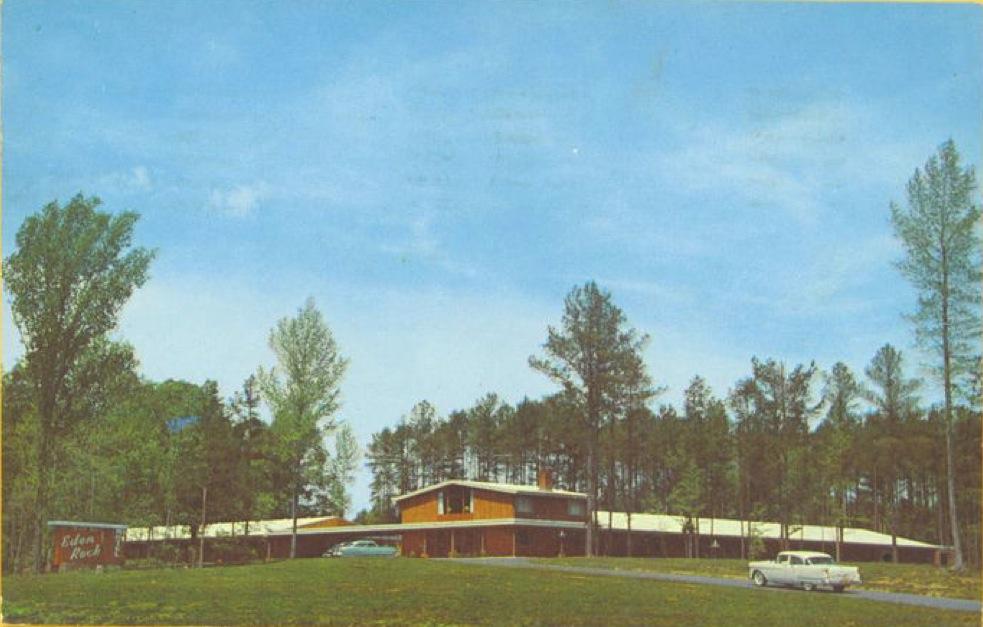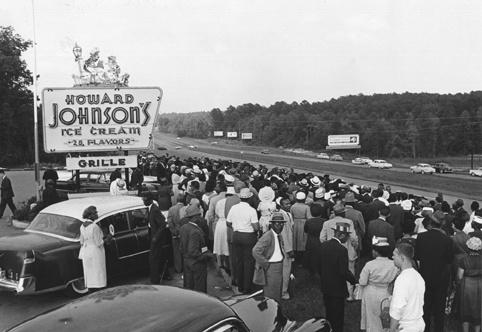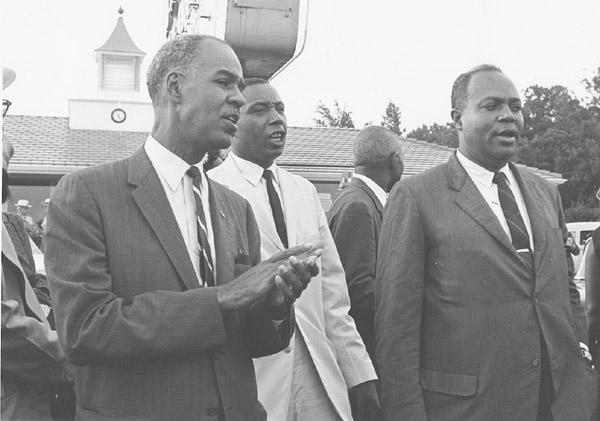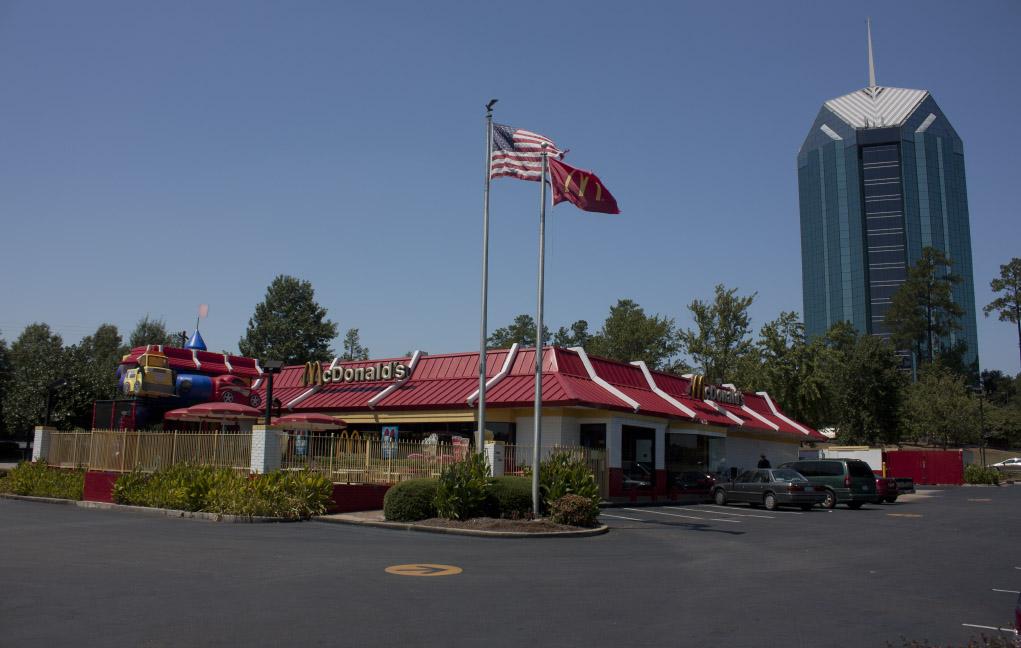EDEN ROCK MOTEL" - "AAA, Located 1 mile west of Durham, N.C. on U.S. 15A and 501A ... Serving Duke University. 40 air-conditioned rooms with TV, radio, and 24-hour telephone service.... Off the highway in fourteen wooded acres. Swimming pool. Howard Johnson restaurant adjoining.... Loran Clark, Owner-Manager.
The Eden Rock was one of the early motels located along 15-501. I don't know when it was constructed, but likely mid-1950s.
Howard Johnson's began as a restaurant in the 1920s, but by the 1950s had branched into the motel business as well, according to Wikipedia. It appears that this Howard Johnson's was solely a restaurant, but associated with the Eden Rock motel.
The restaurant was evidently segregated, and became a focal point for civil rights protests, much as the Royal Ice Cream Parlor had been five years earlier. Per the Durham County Library's Civil Rights Heritage Project:
After the Freedom Rides of 1961 led to integration of interstate buses and terminals, the Civil Rights Movement moved on to "Freedom Highways" in 1962—campaigning to end segregation at establishments that served the traveling public. The Howard Johnson's restaurant on Chapel Hill Boulevard became a focal point in Durham.
On Sunday, August 12, 1962, more than 500 people attended a "Freedom Rally" at St. Joseph's AME Church. Durham attorney Floyd McKissick, already a veteran of 15 years' activism against Jim Crow, acted as master of ceremonies. He was joined by two of the movement's national leaders.
"You cannot live respectably with segregation," Roy Wilkins, executive director of the NAACP, told the crowd; and James Farmer, national director of the Congress of Racial Equality, said, "You're joining the greatest and most exciting battle of the century."
From the church, the crowd proceeded in a caravan of cars to Howard Johnson's parking lot, where they demonstrated with song and prayer against the restaurant's segregation policy and against the trespassing convictions of four members of an earlier protest there. The demonstration ended without incident and would be repeated, Sunday after Sunday, for months—with no result.
"My children got involved first, but when I found out what they were doing, I went with them and all the other young people, and walked those picket lines, too." - Margaret Turner, Durham activist, 1987 interview.
On May 18, 1963, one day after the ninth anniversary of the Brown v. Board decision, mass demonstrations erupted all over Durham. Howard Johnson's was again a target, along with half a dozen other eating places, the courthouse, and city hall. Over the next two days, 850 protesters were arrested, along with four white onlookers, as fights broke out downtown and police stood by with tear gas.
That was the situation welcoming Wense Grabarek into office as Durham's mayor. Elected the same day the demonstrations began, Grabarek asked to speak at an integration rally on May 21. Telling those gathered that their point had been taken and promising to respond, Grabarek won a cessation of protests and, two days later, appointed a Durham Interim Committee to "resolve and reconcile" the city's racial tensions. Over the next few months, segregation ended at most of Durham's restaurants, hotels and movie theaters, along with the swimming pools, libraries, chamber of commerce, and Jaycees.
08.12.62
(Courtesy the Herald Sun via Durham County Library)
Roy Wilkins, Floyd McKissick, and James Farmer, 08.12.62
(Courtesy the Herald Sun via Durham County Library)
The disposition of the Eden Rock and Howard Johnson's after that point is unclear. HoJos took a nosedive nationally during the 1970s and 1980s, so I'm not sure if this one remained open for much longer. The motels and restaurants along Chapel Hill Boulevard were supplanted by other uses after the construction of South Square mall in 1974. Now, like most other significant civil rights locations in Durham, it is gone. But we can still admire the sacrifices of a previous generation as the yellow and red flies proudly over this spot.
08.28.11





Comments
Submitted by Anonymous (not verified) on Wed, 8/31/2011 - 2:00am
The Eden Roc (later named something else) sat well off the service road between the Blair House and Hojo's. The Blair house was razed to build the Circuit City, and the Eden Roc was razed for the University Tower development. There was no Tower Blvd, it now bisects the Eden Roc property. HoJo's and Eden Roc both had semi circular drives that intersected near where there is an ancient double light street light in front of Michael Jordan's Nissan. lwn
Submitted by Michael Bacon (not verified) on Wed, 8/31/2011 - 2:00am
HoJo's was a family favorite in my early childhood, largely because they always had ice cream, which was probably more important to my grandmother and father than it was even to us kids. (Not that we minded!) I keep going back to Moving Midway, Godfrey Cheshire's documentary on moving his ancestor's plantation home, and the attitude of the NYU professor who was descended from slaves from that plantation (as at it turns out, was a distant cousin of Cheshire). His ideal for how best to commemorate the site was that he wanted it bulldozed and paved over with a strip mall parking lot. I get the impression that for a lot of African-Americans, these buildings aren't symbols of history so much as repression. I see that as somewhat short-sited too, but I guess I can see where that might come from.
Submitted by carl (not verified) on Wed, 8/31/2011 - 2:00am
In the 1966 to 1967 time frame while a student at UNC, I remember getting together a car load of us on Wednesdays (I believe) to head out to HOJO's for their all-you-can-eat fish fry. Typical college kids we would not eat all day and then pig out at HOJO's. You could get all the fried fish and fixings you wanted. On one occasion I remember that one member of our party wore out our welcome. He kept requesting additional bowls of fish; while the waitress would bring them, we noticed they got less and less well-cooked until the final batch was just this side of frozen.
Submitted by DFPope (not verified) on Wed, 8/31/2011 - 2:00am
Thanks for clarifying the HOJO location. I believe by the end of the 1960's, there must have been more places to eat, b/c I don't ever remember going there after 1970.
Submitted by BarryN (not verified) on Wed, 8/31/2011 - 2:00am
This HJ was a once a week eating place for us. Mr. and Mrs.Daniels ran it and were the perfect hosts. I remember the 3-D burger, the pickle relish and mustard in the little glass dishes on the table, the chocolate milkshakes, and great breakfasts !
Submitted by Anonymous (not verified) on Wed, 8/31/2011 - 2:00am
McD's. I'm so embarrassed I scrolled down.
Submitted by Gary (not verified) on Wed, 8/31/2011 - 2:00am
lwn So was the Eden Rock located where I had it (the McDonalds site) but the HoJo up the hill at the (currently) Bavarian Restaurant? Honestly, I had a hard time trying to figure this out from some fuzzy old aerials - I could tell where the motels and the Blair House were, respectively, but had no way of telling which building in the 'center' development was associated with the HoJo. Thanks GK
Submitted by Anonymous (not verified) on Wed, 8/31/2011 - 2:00am
I remember the coconut ice cream at HoJo's. Yummy.
Submitted by Anonymous (not verified) on Wed, 8/31/2011 - 2:00am
The HoJo's was really where the Macaroni Grill/Bavarian Restaurant complex is now. It was always just a restaurant. The HoJo's on Hillandale had a motel and dining room. After the boulevard HoJo's closed the building became, among other things, a stereo componet store. I remember buying phonograph needles there. Where the Rooms to Go sits was the Duke Motor Lodge, and the HoJo's sat just across Petty Road on the hill. The building survived the initial South Square boom, surviving, I think, until the current structures were built in the second wave of South Square constuction in the 90's. Often would drive by this HoJo's to go to the Hillandale one because the service there was much better. That whole area would be radically different if the University Tower development had not stalled during the late 80's recession. The plans called for a significant low rise office and retail area, and hotels and restaurants. lwn
Submitted by DFPope (not verified) on Wed, 8/31/2011 - 2:00am
I am so glad you posted something about HOJOs, because I have fond memories of eating Sunday lunches and dinner there in the 1960's. I don't remember any civil rights gatherings there, just their fried clam strips, my favorite. I have always thought Howard Johnsons was located where the 'Rooms to Go' is now, because I remember it being on a hill. I am not sure when it closed but I think it was before South Square was built in 1975. Thanks for all your great work Gary. Your blog brings back some great memories. Hey! Do you think you can dig up a color picture of HOJO's? Black and white, doesn't do it justice. There weren't many places to eat in Durham then, so I am sure others will remember Sunday meals at HOJOs too.
Submitted by Dave Piatt (not verified) on Wed, 9/14/2011 - 2:00am
I remember sitting in front of the Ho Jos in the 1980's and watching 4th of July fireworks being shot off the roof of South Square Mall...
Add new comment
Log in or register to post comments.